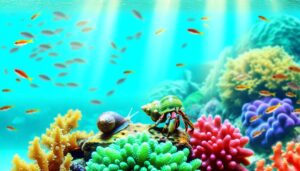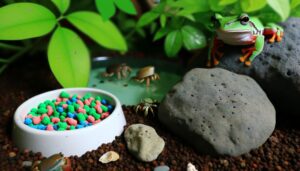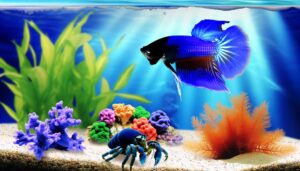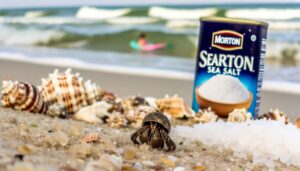Do Hermit Crabs Have Teeth?
Yes, hermit crabs have mouths, and their mouthparts are quite specialized. You'll find that their mandibles and maxillipeds are vital for food manipulation and ingestion.
Mandibles crush food into smaller pieces, while maxillipeds guide and transport it to the mouth, using sensory bristles to detect quality. These specialized appendages enable hermit crabs to consume a versatile diet, ranging from algae to tiny invertebrates.
The efficient enzymatic breakdown and nutrient absorption processes are also essential for their survival. To understand more about these intriguing creatures, consider looking further into their unique adaptations and feeding mechanisms.

Key Takeaways
- Hermit crabs have mouths located on their cephalothorax.
- Their mouths consist of mandibles and maxillipeds.
- Mandibles crush and break down food into smaller pieces.
- Maxillipeds guide food towards the mouth and contain sensory bristles.
- Mouth structure is crucial for feeding and nutrient extraction.
Hermit Crab Anatomy
Hermit crabs possess a fascinating anatomical structure that includes a well-developed cephalothorax, segmented abdomen, and specialized appendages.
You'll find that the cephalothorax houses essential sensory and locomotive organs, including the eyes and antennae.
The segmented abdomen, unlike other crustaceans, is soft and coiled, allowing hermit crabs to snugly fit into their adopted shells.
Specialized appendages, such as chelipeds, serve pivotal roles in feeding, defense, and shell manipulation. Additionally, the walking legs provide mobility, while the uropods help anchor the crab inside its shell.
Understanding these features is crucial for anyone looking to care for hermit crabs, as it enables you to meet their unique needs effectively and compassionately, ensuring their well-being and enriching their environment.
The Structure of Their Mouths
When examining the structure of a hermit crab's mouth, you'll notice it consists of mandibles and maxillipeds that work together to process food.
The feeding mechanism involves these specialized appendages manipulating and breaking down food particles.
Additionally, sensory receptors play a vital role in detecting and discriminating food sources.
Mandibles and Maxillipeds
Ever wondered how hermit crabs manage to eat with such small mouths?
Hermit crabs possess a highly specialized mouth structure comprising mandibles and maxillipeds. The mandibles, robust and chitinous, are the primary crushing tools, enabling the breakdown of food into smaller, manageable pieces.
Surrounding the mandibles are the maxillipeds—three pairs of appendages that act like efficient conveyor belts, guiding food towards the mouth. These maxillipeds also contain sensory bristles, helping the crab assess the edibility of potential food items.
Feeding Mechanism Explained
The feeding mechanism of hermit crabs involves a complex interplay of specialized mouthparts, each meticulously adapted to facilitate the efficient ingestion and processing of food.
You'll find that their mandibles act as strong, cutting tools, breaking down larger food particles. Maxillipeds, which are modified appendages, then assist in manipulating and transporting these particles toward the mouth.
Salivary glands secrete enzymes that initiate the breakdown of food, making it easier to digest. Labrum and labium structures further aid in the sorting and handling of food particles.
Sensory Receptors Role
Beyond their feeding mechanism, hermit crabs' mouths are equipped with specialized sensory receptors that play a pivotal role in detecting and evaluating food quality. These receptors, known as chemoreceptors, are finely tuned to detect chemical signals in their environment.
You'll find these chemoreceptors located on their mouthparts, specifically the maxillipeds and mandibles. They analyze potential food items for nutritional value and safety, ensuring the crab consumes only beneficial substances. This intricate sensory system allows hermit crabs to distinguish between edible and harmful materials efficiently.
How Hermit Crabs Eat
Have you ever wondered how hermit crabs meticulously use their maxillipeds and mandibles to process food efficiently?
When a hermit crab encounters food, it employs its maxillipeds, small appendages near the mouth, to grasp and manipulate the food particles.
These maxillipeds transfer the food to the mandibles, which are robust, jaw-like structures designed to crush and grind.
The mandibles work in concert with the maxillipeds to break down food into smaller, digestible pieces.
This systematic process ensures that nutrients are effectively extracted, enhancing the crab's overall wellbeing.
Feeding Habits and Diet
Hermit crabs demonstrate omnivorous feeding habits, consuming a diverse diet that includes algae, detritus, and small invertebrates. You'll find them scavenging along shorelines, using their chelae to pick up food particles.
Their diet also encompasses plankton, decaying organic matter, and microscopic organisms, making them crucial in nutrient cycling in marine ecosystems. Hermit crabs possess specialized mouthparts, including maxillipeds and mandibles, which enable them to grasp and manipulate various types of food effectively.
This versatility in diet ensures they obtain necessary nutrients, promoting their growth and survival. As you care for hermit crabs, offering a variety of food sources mimics their natural diet and supports their health, aligning with your aim of fostering a thriving environment.
Digestive Process Explained
You'll find that hermit crabs have a complex mouth anatomy, featuring mandibles and maxillipeds, essential for initial food processing.
As food enters their digestive tract, enzymatic breakdown occurs in the stomach and hepatopancreas, facilitating nutrient extraction.
Mouth Anatomy Overview
The mouth of a hermit crab functions as the initial gateway to its complex digestive system, playing an important role in the mechanical breakdown and enzymatic processing of food. As you explore this fascinating anatomy, you'll discover several key components:
- Mandibles: These sturdy structures crush and grind food.
- Maxillipeds: Appendages that handle and filter food particles.
- Salivary glands: Secrete enzymes that initiate the chemical digestion.
- Labrum and labium: Serve to seal the mouth and aid in food manipulation.
- Esophagus: A muscular tube that transports food to the stomach.
Each element works in harmony to guarantee efficient digestion, reflecting a sophisticated adaptation to their environment. Understanding these intricate details enhances your ability to care for hermit crabs effectively.
Food Breakdown Mechanism
In the digestive process of hermit crabs, food particles are initially broken down mechanically by the mandibles before being chemically digested by enzymes secreted from the salivary glands.
You'll find that these mandibles act like powerful jaws, crushing and grinding the food into smaller manageable pieces.
Once the food is sufficiently masticated, it moves to the esophagus and then the stomach. Here, enzymes from the salivary glands and digestive glands further break down the food chemically, turning complex molecules into simpler ones.
This enzymatic activity ensures that proteins, fats, and carbohydrates are effectively decomposed into their fundamental components.
Nutrient Absorption Process
After the food is broken down into simpler molecules, nutrient absorption primarily occurs in the hermit crab's midgut, where specialized cells efficiently transfer nutrients into the bloodstream. These cells, known as enterocytes, are adept at selectively absorbing essential compounds.
You'll find the following key processes in nutrient absorption:
- Facilitated Diffusion: Transport proteins help move nutrients across cell membranes.
- Active Transport: Energy-driven pumps transfer ions and molecules against gradients.
- Endocytosis: Cells engulf nutrient particles, forming vesicles for internal digestion.
- Enzymatic Hydrolysis: Enzymes break down macromolecules into absorbable units.
- Osmosis: Water moves through semi-permeable membranes, maintaining balance.
Understanding these processes ensures you can better care for these fascinating creatures, providing them with the best-suited environment for health and longevity.
Adaptations for Survival
Hermit crabs display remarkable adaptations for survival, including specialized mouthparts that allow them to efficiently consume a variety of food sources. You'll find that their mandibles are robust, designed to crush and grind food, while maxillipeds manipulate and transport it to their mouths.
They also possess chelae, or claws, which not only help in food acquisition but also play an essential role in protection. Hermit crabs can retract into their borrowed shells, using the chelae to block the entrance and deter predators.
Moreover, their ability to detect chemical cues in the environment aids in locating food and identifying threats. These adaptations guarantee hermit crabs thrive in diverse, often challenging habitats, showcasing their evolutionary ingenuity.
Conclusion
In your exploration of hermit crabs, you've revealed the secrets of their intricate mouths, akin to tiny, well-maintained machines. Like clockwork gears meshing perfectly, their feeding habits and digestive processes symbolize nature's precision.
These marvels of adaptation reveal how even the smallest creatures are finely tuned for survival. So, when you observe a hermit crab, remember—you're witnessing a masterpiece of evolutionary engineering, a confirmation to life's incredible complexity and resilience.






